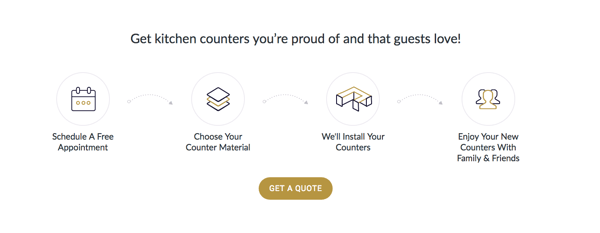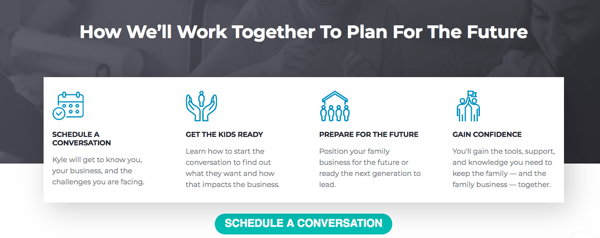How To Write With Clarity: 4 Mistakes That Are Costing You Customers
How do you define clarity? What comes to mind when you hear the word clarity?
I’m sure you can spout off a basic deviation of the Merriam-Webster Dictionary’s definition, but instead, I want you to visit your business’s website and take a simple, quick test.
All you have to do is read the content on your homepage and answer this one question: Is your message clear?
If you believe your website has passed the test, I’m going to ask you to answer a second question: Is the content easy to understand?
Still think you’ve passed with flying colors? Ask yourself this final question: Is your content about more about your business or more about your customer?
Now I’ve got you thinking. If your content speaks to your products and services, or the story of how you started your business more than 40 years ago with just $15 in your pocket, more than it talks about your customer and their problems, then you’ve got a bigger problem than they do.
Why? Because no one is reading your content. In addition to lacking clarity, your content also makes YOU the hero rather than your customers. And who doesn’t want to be the hero of their own story? Content about you is irrelevant to today’s buyer. They are slammed with nearly 3,000 messages a day, so how do you make your message matter to them?
If you find yourself committing these four mistakes, making amends to your audience is past due. Because if you aren’t delighting your customers, you’re not growing your business.
Here’s how to write crystal-clear content that connects with your target audience and makes them listen!
1. You Don't Know Your Customers
To write a clear message, you must understand who will be consuming your message. The only way — and I mean the only way — to do that is by building buyer personas. Creating buyer personas is time-consuming and tedious, and sometimes, you may not have the time or manpower to make them. That’s why I want to tell you about a couple of different ways you can learn about your target audience.
If you are unable to conduct in-depth buyer personas interviews with current customers, past customers, and people who didn’t purchase your product or service, talk to your sales team. They will be able to provide you with key insights and data.
If you don’t have a sales team or you ARE the sales team, casually speak with a few of your customers. Ask them about their buying habits, the pains they were experiencing before they invested in your services, and what life feels like now.
Here are 12 essential questions to ask when building your personas.
While you never want to make assumptions about your audience, there is a shortcut I’ll tell you about. When our clients do not wish to create in-depth buyer personas due to time or budget restrictions, we make persona profiles. The questions are based off buyer persona research from the Buyer Persona Institute, StoryBrand, and the HubSpot persona tool.
Whatever path you choose, believe me when I tell you that you MUST create buyer personas before you begin writing your message.
2. You Didn't Create An Outline
Before you start composing your masterpiece, you should first build an outline. Not only will this help you determine your message but it will also help you stay on message.
At ROI, we follow the StoryBrand framework and use a BrandScript to help our clients clarify their message. This is always the first step we take when producing new content.
Learn more about BrandScripts, here, or by watching this video.
3. You're Using Too Much Copy
When people go to your website, they are looking for a solution to their problem. First and foremost, they want to know what’s in it for them. Whether it’s your homepage or the bio on your about page, all of your copy should be about how your brand helps your customers.
I’m sure you have a lovely family and a fascinating story about how your business got started, but unfortunately, no one truly cares. Except for your mom. Review the copy on your website, emails, blog, and social media, and CUT IT DOWN. It doesn’t matter if it’s cute, clever, or catchy; if people aren’t reading it, it’s not working.
I recommend this book by world-renowned copywriter, Ray Edwards, who also led the StoryBrand Copywriting Course I attended.
4. You're Missing A Clear Offer & Path
Two of the critical pieces of the StoryBrand Framework are the Offer and the Plan. What do I mean by that?
Customers need to easily and quickly understand what you offer. While you may provide an array of services or products, you need to focus on one offer or one goal. For example, at ROI, we provide content marketing, email marketing, web design, social media, marketing automation, sales enablement, and…… I’ve already lost you, haven’t I?
You wouldn’t read all that would you? So instead of rambling about all of our services, we focus on what those services mean for our customers: we do the marketing for you. That message is simple AND short.
Next, you must ensure you provide people with a clear path to follow. What do I mean by a “path?” People are coming to your website because they are searching for a solution you offer. However, if you don’t provide them with the directions they need to take to get your solution, you’ve lost them.
You need to make it obvious how to do business you. What do people need to do to engage with your brand? Here are a couple of different options you can use.
The first is a process plan. This is a simple three- or four-step plan. Take this example from a granite and quartz countertop installation company.

This is a clear path that’s easy for anyone to understand. It’s apparent what people need to do in order to get new granite or quartz kitchen countertops. Look how easy it is to do business with this company?

This is an example of a success plan from a family business advisor. The steps aren’t all action-oriented but rather convey a transformation. The path and solution are clear. Achieving these goals appears simple.
How To Clarify Your Brand’s Message
I’ve provided you with four steps on how to clarify your brand’s message. However, I understand that writing content isn’t your primary job. You have a business to run, a department to lead, and a million other responsibilities to juggle.
That’s why at ROI, we clarify your message for you — and fast. With the ROI QuickStart, you will not only clarify your message but after just 120 days of teaming up with our StoryBrand Certified and HubSpot Platinum Partner Agency, you will be equipped with a
- marketing machine
- lead-generating campaign
- and marketing and sales materials that follow the StoryBrand framework
all built into the leading all-in-one marketing and sales platform, HubSpot.
Connect with your audience through powerful storytelling, inbound marketing, and smart automation. To learn more about the ROI QuickStart and find out if it’s a good fit for your business, download our free QuickStart Plan.






